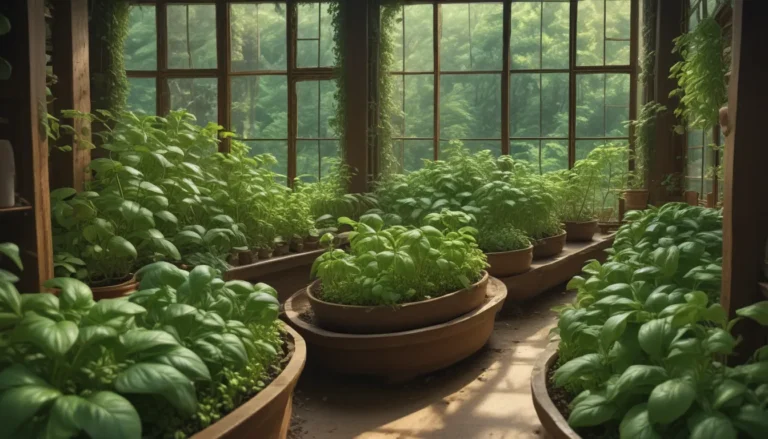The Ultimate Guide on Growing Fruit Trees in a Greenhouse

Are you a gardener who dreams of enjoying the delightful taste of fresh fruits grown right in your backyard? Imagine plucking your very own ripe apricots, juicy oranges, or sweet peaches from trees thriving in your greenhouse. While it may seem like a lofty goal, the reality is that you can successfully grow fruit trees in a greenhouse, even in a cold climate.
In this comprehensive guide, we will explore the benefits of growing fruit trees in a greenhouse, provide tips for planning your project, discuss varieties to consider, and offer suggestions for setting up your greenhouse for optimal fruit production.
What You’ll Learn
Let’s dive into the exciting world of greenhouse fruit growing and discover everything you need to know to set up a successful fruit tree operation within your outdoor structure.
Why Grow Fruit in a Greenhouse?
Growing fruit trees in a greenhouse provides a wide array of benefits that are making this method increasingly popular on a commercial scale. Some advantages of growing fruit trees in a greenhouse include:
- Extending the harvest period by starting earlier and lasting longer
- Ensuring higher quality harvest with less chemical use, especially fungicides
- Protection from adverse weather conditions such as wind, rain, frost, and pests
- Weed control and reduced competition for resources
By leveraging the controlled environment of a greenhouse, you can grow fruit varieties that may not survive in your local climate and even experiment with fruits that require longer growing seasons.
Before You Get Started
Before embarking on your greenhouse fruit tree journey, take some time to plan your project meticulously. Consider factors such as the types of fruit trees you want to grow, whether you’ll plant directly in the soil or use containers, and whether your greenhouse will be heated or unheated.
Additionally, think about the space requirements of your fruit trees, especially considering their potential size. Dwarf varieties are an excellent option for managing space constraints and facilitating easy movement of potted specimens in and out of the greenhouse.
Types of Fruit Trees for Greenhouses
When it comes to selecting fruit trees for your greenhouse, you have a wide range of options from tropical, subtropical, and temperate climates. Some common fruits that thrive in greenhouses include:
- Apricot
- Avocado
- Banana
- Fig
- Grapefruit
- Guava
- Kumquat
- Lemon
- Lime
- Lychee
- Mandarin
- Mango
- Nectarine
- Orange
- Peach
- Persimmon
- Pomegranate
For novice greenhouse fruit growers, start with less demanding varieties like Meyer Improved lemons or Calamondin oranges. Additionally, consider container-friendly fruits like figs that offer a double harvest during the summer.
Cultivars to Select
Choosing the right cultivars is crucial for the success of your greenhouse fruit tree project. Select varieties that align with your climate, space, and care preferences. Some recommended cultivars include:
- Meyer Improved Lemon
- Bonfire Peach
- Brown Select Satsuma
- Miss Figgy Fig
- Dwarf Cavendish Banana
Each cultivar offers unique characteristics and flavors, catering to diverse tastes and preferences. Ensure you match the cultivars’ requirements for successful pollination and fruit set.
Pollination
In a greenhouse environment, you may need to take on the role of pollinating insects for certain fruit tree varieties. For self-infertile trees, manual pollination using a paintbrush or similar tool may be necessary during the flowering period.
Alternatively, opt for self-fertile varieties to simplify the pollination process and ensure a reliable harvest.
Greenhouse Setup
Setting up your greenhouse for optimal fruit tree growth involves managing critical factors such as light, humidity, and temperature. Let’s delve into these essential aspects to create a thriving environment for your fruit trees.
Light
Greenhouse materials can reduce sunlight penetration, affecting plant growth. To maximize light distribution, use reflective films on the floor and transparent walls. Regular cleaning and maintenance will enhance light exposure, promoting healthy growth.
Humidity
Maintaining optimal humidity levels is crucial for fruit trees, varying before and after flowering. Use retractable films or ventilation systems to regulate humidity based on specific fruit requirements. Adequate ventilation prevents disease development while preserving a healthy greenhouse environment.
Temperature
Monitoring and controlling temperature fluctuations is vital for fruit tree development. Avoid extreme temperatures that can impact blooming and fruiting. Protect your plants from cold nights with insulating materials like mulch or blankets for potted specimens.
By ensuring these environmental factors are balanced, you can create an ideal growing environment for your greenhouse fruit trees, maximizing your harvest potential.
Overcoming Challenges and Reaping Rewards
While growing fruit trees in a greenhouse presents challenges, the rewards are well worth the effort. Enjoy the satisfaction of harvesting your homegrown fruits throughout the year and relish the unique flavors of freshly picked produce.
If you’re a greenhouse owner or planning to build one, consider adding fruit trees to your gardening repertoire. Share your successes and challenges in the comments below, and inspire others to embark on their greenhouse fruit growing journey.
For more greenhouse gardening tips and resources, explore our informative guides:
- How to Grow Herbs in a Greenhouse
- Tips for Growing Succulents in a Greenhouse
- How to Avoid 11 Common Greenhouse Mistakes
- How to Identify and Manage Common Greenhouse Pests
With the right knowledge and preparation, you can transform your greenhouse into a thriving fruit tree paradise, providing a bountiful harvest season after season.
Now, are you ready to unlock the full potential of your greenhouse and grow a diverse range of fruit trees in your backyard oasis? Let’s embark on this exciting journey together!





